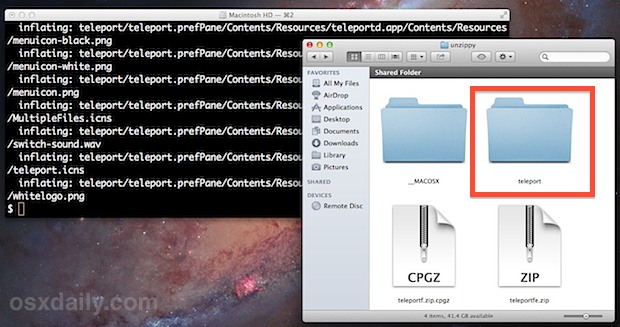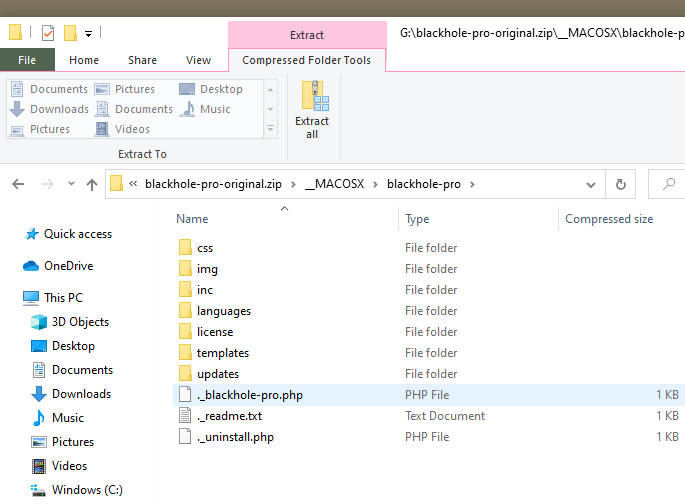Now you can now run any ADB command on your device form your Windows PC. How to Install ADB on MAC. Visit this Google page to Download the ADB ZIP file for MacOS. Now extract the folder on your desktop. Open Terminal on Your MAC. Now to browse to the folder you extracted ADB into, enter the following command on Terminal. Common compressions applied to a.tar file are Gzip, bzip2, and xz. That's why you rarely see just a.tar file and more commonly encounter.tar.gz or.tgz files. On Linux, BSD, Illumos, and even Mac OS, the tar command is already installed for you.
- Unzip File Mac Command Line Shortcut
- Unzip Multiple Files Mac Command Line
- Unzip File Mac Command Line
- Unzip File Mac Command Line Linux
- Unzip Tar File Mac Command Line
Here we are again with a nice How-to Guide for the Android Lovers. This post is about the ADB and fastboot drivers and how to Install ADB on Windows, MAC, and Linux. ADB, Android Debug Bridge, is a command-line utility which helps you to run the ADB and fastboot commands on your android devices. In a simple way, we can say that ADB and FASBTOOT are the tools which allow you send terminal commands to your phone from your computer via USB. They both serve different functions, but they are must for the Android Phone users.
Suppose you want to customize your Android Devices like Install TWRP on the phone, Root the Android Phone to make changes in the system or Install Custom ROM on your Stock Android phone. Then you need to run some ADB and Fastboot commands. At that time you need these ADB and fastboot drivers on your Windows, MAC, and Linux.
There are so may tutorial are available on the internet to install the ADB setup files, but sometime they will not work or outdated. So here we are providing you the latest ADB drivers and that is direct from the Google Servers. Which means these ADB drivers are updated and work on any System and Android Devices. All you have to follow the below mention tutorial to setups the ADB and fastboot drivers on Windows, MAC, and Linux. So let’s get started and install ADB on your desktop.
Table of Contents
- 1 Guide To Install ADB and Fastboot
Guide To Install ADB and Fastboot
NOTE:- Install ADB on Your Desktop is a half process to complete the whole ADB setup you need to make some changes on your smartphone or tablet to accept the ADB commands.
Allows USB debugging On Android Devices
1. Open the Setting page on your device.
2. From here Tap on the About Phone option generally near the bottom of the list (this is hidden behind the “System” option in Google’s latest Android Oreo version).
3. In the about phone section of your phone, Tap the Build Number option 7 times to enable Developer Mode. And you will see a popup message on your screen “You are now a developer”.
4. Now go back to the Settings page and you should see a new Developer Options menu here.
5. Go in there and scroll down to USB debugging and turn the toggle on. This will enable the USB debugging On Android.
Unzip File Mac Command Line Shortcut
Now all you have to setup the ADB files on your desktop. Follow the rest of the instructions for your particular operating system.
Install ADB on Windows Desktop
1. Visit this Google page to Download the ADB ZIP file for Windows.
2. Unzip the folder on your Windows C Drive. (C:platform-tools).
3. Open the ADB Platform-Tools folder. Next, open a terminal window in the folder where you have ADB and fastboot installed. On Windows, you can right-click and click open command window here. (Some Windows 10 users may see “PowerShell” instead of “command prompt”.)
4. Now connect your phone to the Windows PC with the USB cable.
5. Now enter the following command in the command prompt window to check the connection between PC and Phone.
Your device’s serial number should appear in the command window.
6. Also on your phone’s screen, you should see a pop screen to allow or deny USB Debugging access. Grant USB Debugging access when prompted (and tap the always allow check box if you never want to see that prompt again).
That’s it! Now you can now run any ADB command on your device form your Windows PC.
How to Install ADB on MAC
1. Visit this Google page to Download the ADB ZIP file for MacOS.
2. Now extract the folder on your desktop.
3. Open Terminal on Your MAC.
4. Now to browse to the folder you extracted ADB into, enter the following command on Terminal window.
On my MAC the command looks like this cd /Users/Sid/Desktop/platform-tools/
5. Now connect your phone to the MAC with the USB cable.
6. Now enter the following command in the Terminal window to check the connection between MAC and Phone.
7. Now on your device, you’ll see an “Allow USB debugging” prompt. Allow the connection.
Voila! You successfully install the ADB on MAC OS.
How to Install ADB on Linux
1. Visit this Google page to Download the ADB ZIP file for MacOS.
2. Now extract the folder on your Linux desktop.
3. Open the Terminal app on your Linux machine to follow the next step to install ADB.
4. Now to browse to the folder you extracted ADB into, enter the following command on Terminal window.
On my MAC the command looks like this cd /Users/Sid/Desktop/platform-tools/

Unzip Multiple Files Mac Command Line
5. Now connect your Android Device to the Linux with the USB cable.
6. Now enter the following command in the Terminal window to check the connection between Linux and Android SmartPhone.
7. Now on your device, you’ll see an “Allow USB debugging” prompt. Allow the connection.
Voila! You successfully install the ADB on your Linux Desktop.
So with this way you easily install and setup ADB on your Windows, MAC, and Linux. You can also check some of the Other guides here to install ADB and fastboot, Fastest Method to Setup ADB and Fastboot on Windows and Install ADB and Fastboot on Mac, Linux, Chrome OS With Nexus Tool Script
Zip is a file compression utility. It is the default file compression utility on Windows and widely used in Windows operating system. The Zip compressed files are also called zip files. The best thing about Zip is that it is cross platform. Zip files can be opened in Mac OS, Windows and Linux. You can also create Zip files from Mac OS, Windows, and Linux and open it in other operating systems.On Linux based operating systems such as CentOS, the unzip command is used to open Zip files.
In this article I will show you how to use the unzip command to open Zip files on CentOS. I am going to use CentOS 7 for the demonstration. Let’s get started.
On CentOS 7, the unzip package may not be installed by default. But it is available in the official package repository of CentOS 7. So it is very easy to install.
First update the YUM package repository cache with the following command:
The YUM package repository cache should be updated.
Now install unzip with the following command:
Now press y and then press <Enter> to continue.
unzip should be installed.
Now to check whether unzip works, run the following command:
As you can see, unzip is working perfectly.
Working with Zip Files Using Graphical User Interface:

If you have graphical desktop environment such as GNOME desktop environment installed on your CentOS operating system, then working with Zip files is pretty easy.
As you can see, I have app.zip file in the ~/Downloads directory of my HOME directory.
Now if you right click on the zip file, you should be able to see the following options. The first option is Open With Archive Manager. If you double click on a Zip file, it will open with the Archive Manager by default.
You can also click on Extract Here to extract the zip file.
As you can see, the zip file is opened in the Archive Manager and I can see all the contents of the Zip file.
From the Archive Manager, you can click on Extract to extract the contents of the Zip file.
You should see the following window. You can click on the Extract button to extract the Zip file in the current directory. If you wish, you can create a new folder and extract the contents of the Zip file there.
I create a new directory myapp/ and extracted the contents of the Zip file there.
As you can see, the contents of the Zip file are correctly extracted into the myapp/ directory.
You can also select specific files and folders from the Archive Manager and drag and drop them on a directory. Only your desired files and folders will be extracted.
Listing the Contents of the Zip file using unzip Command:
You can list all the files and directories stored inside a Zip file with the following command:
As you can see, all the contents of the Zip archive app.zip is listed.
Extracting a Zip File using unzip Command:
You can extract a Zip file using the unzip command very easily.
To extract a Zip file into the current directory where the zip file is, run the following command:
NOTE: Here app.zip is the Zip file that I am extracting.
Unzip File Mac Command Line
The contents of the Zip file should be extracted to your current working directory.
Unzip File Mac Command Line Linux
As you can see, all the files and directories of app.zip is extracted.

In the earlier example, all the files were extracted in the current directory. You may want to extract the contents of the Zip file to any specific directory. You can also do that with the unzip command.
First create the directory where you will be extracting the Zip file with the following command:
Now run the following command to extract the Zip file app.zip into the
$ unzip app.zip -d ~/Downloads/myapp
The contents of the app.zip file is extracted into the ~/Downloads/myapp directory as you can see in the screenshot below.
The ls command also verifies that the Zip file was extracted in the desired directory.
Unzip Tar File Mac Command Line
Extracting Specific Files from the Zip File using unzip Command:
You can also extract specific files and directories from the Zip file using unzip command.
For example, let’s say you want to extract only server.js file from app.zip file, run the following command:
As you can see, only server.js was extracted to the current working directory.
You can also specify a directory where the files and directories should be extracted as follows:
You can also extract a specific subdirectory from the Zip file as follows:
As you can see the directory models/ and all the contents of the directory was extracted into the ~/Downloads/myapp directory.
That’s how you use Unzip on CentOS. Thanks for reading this article.
